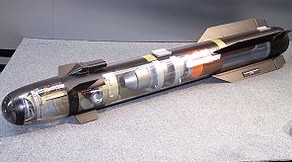
AGM-114 Hellfire
Wikipedia | 2013-09-30 17:33
The AGM-114 Hellfire is an air-to-surface missile (ASM) developed primarily for anti-armor use. It has multi-mission, multi-target precision-strike capability, and can be launched from multiple air, sea, and ground platforms. The Hellfire missile is the primary 100 lb-class air-to-ground precision weapon for the armed forces of the United States and many other nations.
The AGM-114 Hellfire is a combat-proven tactical missile system; the missile has been in combat use since the mid-1980s.
Description
The Hellfire today is a comprehensive weapon system, one that can be deployed from rotary- and fixed-wing aircraft, waterborne vessels and land-based systems against a variety of targets.
The development of the Hellfire Missile System began in 1974 with the U.S. Army requirement for a "tank-buster", launched from helicopters to defeat armored fighting vehicles. Production of the AGM-114A started in 1982. The Development Test and Evaluation (DT&E) launch phase of the AGM-114B took place in 1984. The DT&E on the AGM-114K was completed in Fiscal Year (FY)93 and FY94. AGM-114M did not require a DT&E because it is the same as the AGM-114K except for the warhead. Most variants are laser guided with one, AGM-114L "Longbow Hellfire", being radar guided. Laser guidance can be provided either from the launcher, such as the nose-mounted opto-electronics of the AH-64 Apache attack helicopter, other airborne target designators or from ground based observers, the latter two options allowing the launcher to break line of sight with the target and seek cover.

Cockpit video showing the missile being used in Afghanistan against two human targets on a road.
The Hellfire II, developed in the early 1990s is a modular missile system with several variants for maximum battlefield flexibility. Hellfire II's semi-active laser variants—AGM-114K high-explosive anti-tank (HEAT), AGM-114KII with external blast fragmentation sleeve, AGM-114M (blast fragmentation), and AGM-114N metal augmented charge (MAC)—achieve pinpoint accuracy by homing in on a reflected laser beam aimed at the target. Predator and Reaper UCAVs carry the Hellfire II, but the most common platform is the AH-64 Apache helicopter gunship, which can carry up to 16 of the missiles at once. The AGM-114L, or Longbow Hellfire, is a fire-and-forget weapon: equipped with a millimeter wave (MMW) radar seeker, it requires no further guidance after launch—even being able to lock-on to its target after launch[7]—and can hit its target without the launcher or other friendly unit being in line of sight of the target. It also provides capability in adverse weather and battlefield obscurants (obscurants such as smoke and fog being able to mask the position of the target or to prevent the designating laser from producing a detectable reflection). Each Hellfire weighs 47 kg / 106 pounds, including the 9 kg / 20 pound warhead, and has a range of 8,000 meters. The AGM-114R or "Romeo" is planned to enter service in late 2012. It uses a semi-active laser homing guidance system and an integrated blast fragmentation sleeve warhead to engage targets that previously needed multiple Hellfire variants. It will replace AGM-114K, M, N, and P variants in U.S. service.
The Joint Common Missile (JCM) was to replace Hellfire II (along with the AGM-65 Maverick) by around 2011. The JCM was developed with a tri-mode seeker and a multi-purpose warhead that would combine the capabilities of the several Hellfire variants. In the budget for FY2006, the U.S. Department of Defense canceled a number of projects that they felt no longer warranted continuation based on their cost effectiveness, including the JCM. A possible new JCM successor called the Joint Air to Ground Missile (JAGM) is under consideration.
Combat history
Since being fielded, Hellfire missiles have proven their effectiveness in combat in Operation Just Cause in Panama, Operation Desert Storm in Persian Gulf, Operation Allied Force in Yugoslavia, Operation Enduring Freedom in Afghanistan, in Operation Iraqi Freedom, where they have been fired successfully from Apache and Super Cobra attack helicopters, Kiowa scout helicopters, and Predator unmanned combat air vehicles (UCAVs).
From 2001 to 2007, the U.S. military fired over 6,000 Hellfires in combat. It has found the missile effective in urban areas, as the relatively small warhead reduces the risk of civilian casualties.
The only known operational air-to-air kill with a Hellfire took place on 24 May 2001. A civilian Cessna 152 aircraft entered Israeli airspace from Lebanon, with unknown intentions and refusing to answer or comply with ATC repeated warnings to turn back. Fearing a terrorist attack, an Israeli Air Force AH-64A helicopter fired upon the Cessna, resulting in its complete disintegration,and the death of Estephan Nicolian, a student pilot.
In 2008, the usage of the AGM-114N variant caused controversy in the United Kingdom when it was reported that these thermobaric munitions were added to the British Army arsenal. Thermobaric weapons have been condemned by human rights groups.The UK Ministry of Defence refers to the AGM-114N as an "enhanced blast weapon".
The AGM-114 has been the munition of choice for airborne targeted killings that have included high-profile figures such as Ahmed Yassin (Hamas leader) in 2004 by the Israeli Air Force and; Anwar al-Awlaki (American-born Islamic cleric and Al Qaeda in the Arabian Peninsula leader) in Yemen in 2011, and Abu Yahya al-Libi in Pakistan in 2012 by the United States.
Share this page




















